Our Services
Industrial strategy
Market analysis
Economic and industrial development advice
Feasibility studies: technical and economic
Due Diligence: technical, markets, commercial
Financial modelling
Simulation modelling for management decisions
MODELLING – AUDITING REVIEW AND TROUBLE SHOOTING
When using models to support the design of costly marine works, it is crucial that calibration and verification are sufficiently accurate for the intended purpose. An assumption that well tried modelling systems will automatically generate accurate models is a false premise. Accurate models rely primarily on bathymetry and boundary data. No amount of so-called “calibration adjustment” will substitute for these two sets of data. Poor boundary configuration in terms of boundary condition, position and boundary data can lead to difficulties calibrating and verifying a model to the required high standard to support EIA, long term planning and design support. TechnoEconomica carries out model audits, reviews and troubleshooting of models of coastal, fluvial and lake processes.
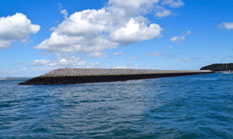 TechnoEconomica was asked to troubleshoot a model that had been used to support the positioning and design of a breakwater at the entrance to a busy estuary. Only after a breakwater had been almost completely constructed were discrepancies between model predictions and actual current speeds observed. Vessels entering the harbour were deflected from required tracks due to higher than anticipated current speeds during certain states of the tide. Unexpected changes to the sediment distribution were also noted. Our investigations revealed a number of errors in the model in particular poorly specified boundary conditions and a circular calibration method. We recommended a regional model would be required to generate accurate boundary data for a new local model of the harbour. Up to date bathymetry combined with a flexible mesh modelling system and better calibration and verification process resulted in a far more reliable and accurate model. The new model was used to derive measures to reduce the high currents (using training walls for example) and was the driver for a sediment model. The project highlighted how important it is to understand that however good a modelling system is, a model of a particular area must be well specified, calibrated and verified in order to evolve into a tool that can be used with confidence to support what are usually capital-intensive marine structures, outfalls and other coastal works.
TechnoEconomica was asked to troubleshoot a model that had been used to support the positioning and design of a breakwater at the entrance to a busy estuary. Only after a breakwater had been almost completely constructed were discrepancies between model predictions and actual current speeds observed. Vessels entering the harbour were deflected from required tracks due to higher than anticipated current speeds during certain states of the tide. Unexpected changes to the sediment distribution were also noted. Our investigations revealed a number of errors in the model in particular poorly specified boundary conditions and a circular calibration method. We recommended a regional model would be required to generate accurate boundary data for a new local model of the harbour. Up to date bathymetry combined with a flexible mesh modelling system and better calibration and verification process resulted in a far more reliable and accurate model. The new model was used to derive measures to reduce the high currents (using training walls for example) and was the driver for a sediment model. The project highlighted how important it is to understand that however good a modelling system is, a model of a particular area must be well specified, calibrated and verified in order to evolve into a tool that can be used with confidence to support what are usually capital-intensive marine structures, outfalls and other coastal works.
POWER STATION THERMAL PLUMES
The ever-increasing demand for power is set against the need to ensure that the impact of thermal plumes is minimised and that waste heat is put to use wherever possible. Power stations of any size which rely on gas, oil or nuclear steam generation all require cooling water for the condenser. CCGT systems also require cooling water for the secondary steam generation condenser. 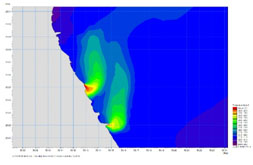 The thermal loads vary greatly but large power stations may dump several GW of heat into the water body designated for cooling water supply. The capacity of all water bodies is limited and is also governed by a need to restrain the impact of temperature rise and thermal shock on ecosystems. Recirculation of discharged cooling water into intakes and other systems such as nearby desalination plants must be avoided.
The thermal loads vary greatly but large power stations may dump several GW of heat into the water body designated for cooling water supply. The capacity of all water bodies is limited and is also governed by a need to restrain the impact of temperature rise and thermal shock on ecosystems. Recirculation of discharged cooling water into intakes and other systems such as nearby desalination plants must be avoided. 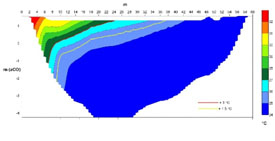 Even though renewables are making a greater contribution to the overall energy supply a base load generated by power stations will always be needed. In the future fusion power will still require cooling water. If SMRs are build they too will require cooling water. The need to ensure minimal impact from these systems will remain.
Even though renewables are making a greater contribution to the overall energy supply a base load generated by power stations will always be needed. In the future fusion power will still require cooling water. If SMRs are build they too will require cooling water. The need to ensure minimal impact from these systems will remain.
TechnoEconomica has undertaken numerous studies for various clients including IBM, Canal and Rivers Trust, ETI AEA and ARAMCO among others providing modelling services to support EIAs and optimal positioning of outfalls. We have also supported very large infrastructure design modelling four multi-GW power stations, phosphate plant discharges and several desalination systems all in one large development. Outfall location optimisation, recirculation avoidance and cooling system specification advice have all been completed. We apply MIKE3 by DHI and our own Aquatic Heat Model for this work.
For more details please follow this linkKEEPING RIVERS COOL
Climate change and the ever-increasing need for additional water supply are putting pressure on rivers, including those that are top quality salmon and trout rivers. TechnoEconomica has carried out several important studies with its Aquatic Heat Model to study some of these issues. 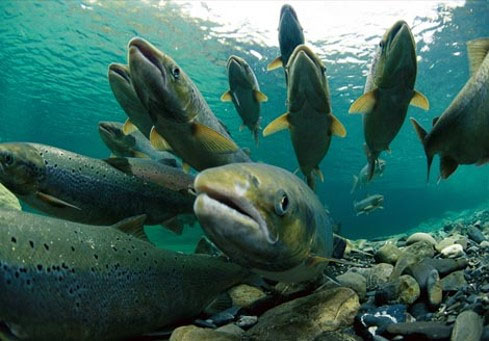 Simulations using accurately calibrated models have shown that river temperatures are most strongly governed by weather conditions, particularly wind, air temperature and humidity but that shading also plays a crucial role. Unshaded rivers suffer a greater diurnal and seasonal temperature range than shaded rivers. Low thick riparian vegetation which reduces surface wind speed and provides little shading can actually increase river temperatures in contrast to thickly leaved trees which reduce mean temperature and temperature range.
Simulations using accurately calibrated models have shown that river temperatures are most strongly governed by weather conditions, particularly wind, air temperature and humidity but that shading also plays a crucial role. Unshaded rivers suffer a greater diurnal and seasonal temperature range than shaded rivers. Low thick riparian vegetation which reduces surface wind speed and provides little shading can actually increase river temperatures in contrast to thickly leaved trees which reduce mean temperature and temperature range. 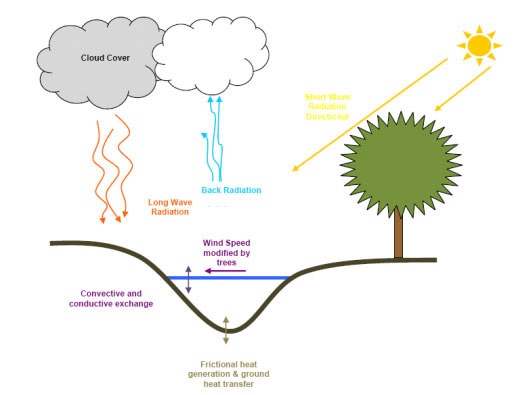 Water temperature can also be increased where a river is shallow and flows are substantially reduced for example by abstraction increases. An important conclusion from these studies is that riparian foliage can be used as a river temperature management tool. The modelling system developed by TechnoEconomica simulates the long-term thermal evolution of rivers and streams using our MOL solution of the St Venant equations. The system accounts for every aspect of heat exchange including solar, atmospheric, ground and the influence of foliage and buildings on dynamic heat balance. Seasonal changes in the foliage are included as is the distribution of wind velocity at the water surface. The modelling system can be used to support river temperature management.
Water temperature can also be increased where a river is shallow and flows are substantially reduced for example by abstraction increases. An important conclusion from these studies is that riparian foliage can be used as a river temperature management tool. The modelling system developed by TechnoEconomica simulates the long-term thermal evolution of rivers and streams using our MOL solution of the St Venant equations. The system accounts for every aspect of heat exchange including solar, atmospheric, ground and the influence of foliage and buildings on dynamic heat balance. Seasonal changes in the foliage are included as is the distribution of wind velocity at the water surface. The modelling system can be used to support river temperature management.
DESALINATION SYSTEMS
Desalination has been known about for millennia though in limited form, as observed by Aristotle. It was even used practically in the Middle Ages. Desalination is energy intensive and only in the last few decades has it been used on a very large scale to provide much needed fresh water in very arid zones. Climate change has altered rainfall distribution and the naturally occurring supplies of fresh water have been impacted particularly in the last two decades. Desalination is becoming an increasingly common method of providing larger volumes of fresh water in wider areas, including those areas where previously fresh water was sufficiently available from natural sources. The largest systems, exemplified by the Ras Al-Khair Hybrid MSFD and RO system, can supply about 11.5 m3s-1 of high-quality water. The discharge from such systems may be at elevated temperature and up to double the ocean salinity. Cleaning chemicals such as sodium metabisulphite may be used to clean RO membranes. The near field temperature salinity and chemical distributions are limited by regulations and the need to minimise impact on benthic species. TechnoEconomica has completed numerous projects in this context to provide:
- Specification of marine surveys
- Analysis of survey data
- 3-D Modelling of heat and salt
- Prediction of the long-term plume evolution
- Diffuser optimisation and design support
- Navigation through regulatory issues
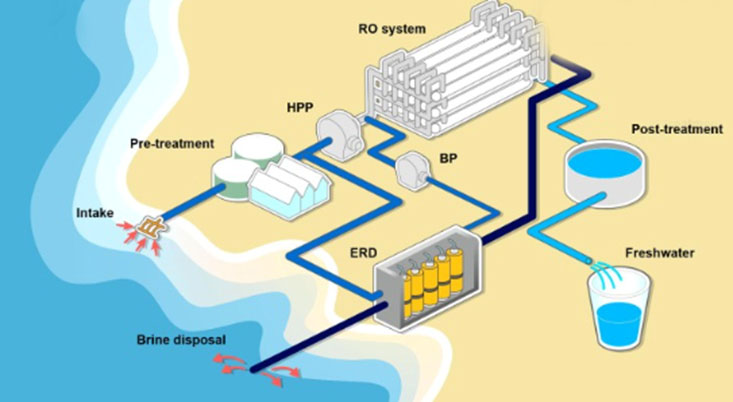
DATA CENTRE FREE COOLING
Data centres are increasing in number rapidly as the demands for data storage and processing expand. Large data centres can generate 10 MW of heat which must be dissipated. Some of this waste heat may be utilised in CHP schemes but electrically driven cooling may also be needed which is costly. 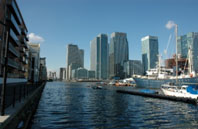 If CHP is not an option a more efficient solution is to dissipate the heat in a nearby water body. In a highly urbanised environment such as London, docks provide opportunities for free cooling systems to be combined with more conventional systems with excellent potential cost savings. The capacity of such water bodies is limited and governed by a need to limit the impact of temperature rise and thermal shock on fish populations and the requirement to avoid recirculation of discharged cooling water into intakes.
If CHP is not an option a more efficient solution is to dissipate the heat in a nearby water body. In a highly urbanised environment such as London, docks provide opportunities for free cooling systems to be combined with more conventional systems with excellent potential cost savings. The capacity of such water bodies is limited and governed by a need to limit the impact of temperature rise and thermal shock on fish populations and the requirement to avoid recirculation of discharged cooling water into intakes. 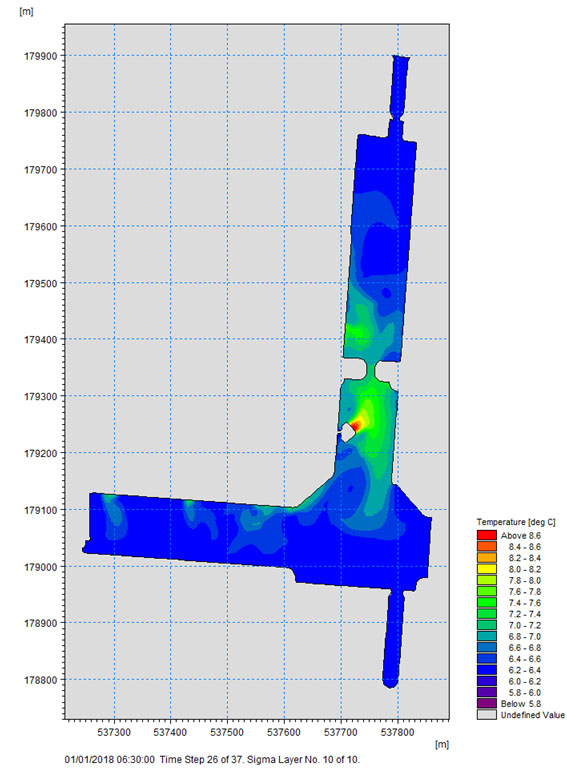
SURVEYS & TIDAL ANALYSIS
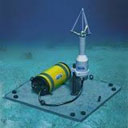 Modelling work which supports engineering works demands excellent modelling systems but also requires data of appropriate quantity and type. Calibration of a tidal hydrodynamic model demands at least one month of tidal data and complex water quality models may require many months of data. If a lake or dock is to be used as a heat sink then the vertical and spatial temperature distribution should be measured over at least one year. Surveys can be expensive and therefore the allocated funds must be spent effectively.
TechnoEconomica has experience specifying surveys in a wide range of environments and for various levels of project detail. Examples include:
Modelling work which supports engineering works demands excellent modelling systems but also requires data of appropriate quantity and type. Calibration of a tidal hydrodynamic model demands at least one month of tidal data and complex water quality models may require many months of data. If a lake or dock is to be used as a heat sink then the vertical and spatial temperature distribution should be measured over at least one year. Surveys can be expensive and therefore the allocated funds must be spent effectively.
TechnoEconomica has experience specifying surveys in a wide range of environments and for various levels of project detail. Examples include:
- Hydrographic and thermal surveys for a large infrastructure project in the Gulf of Arabia
- Tidal and current survey in the Red Sea for a large jetty associated with a land-based ammonia production facility
- Tidal and current survey in the Red Sea for a large jetty associated with a land-based ammonia production facility
- Bathymetric, tidal, current, thermal and salinity survey in Bahrain Bay for an RO plant outfall and intake location and EIA study
- Surveys of surface and vertical temperature and salinity distribution in urban docks to support long term modelling of temperature evolution and discharge consent applications.
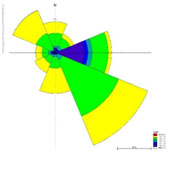 We also carry out data analysis and presentation for model calibration and verification. We have our own modern high-speed software which accommodates both the IOS and Simplified Admiralty methods of prediction and analysis for water level and current vector time series. For the IOS method an optimal set of components can be automatically selected. Other facilities include:
We also carry out data analysis and presentation for model calibration and verification. We have our own modern high-speed software which accommodates both the IOS and Simplified Admiralty methods of prediction and analysis for water level and current vector time series. For the IOS method an optimal set of components can be automatically selected. Other facilities include:
- Current vector time series prediction based on tidal diamonds
- Tide tables using either IOS or SAM data
- Analysis of complete model results data sets to generate co-tidal and co-phase plots
- Operational windows based on tidal elevation and/or current speed